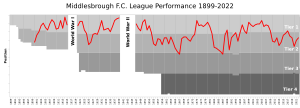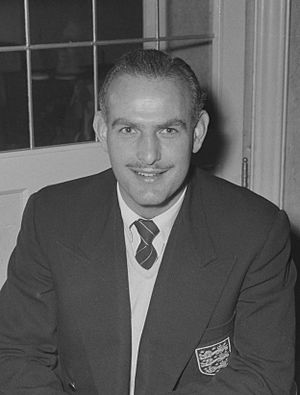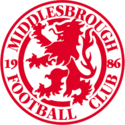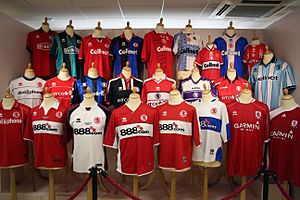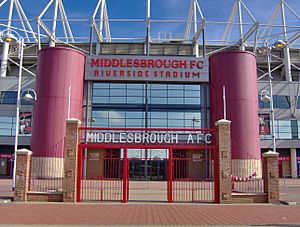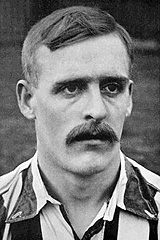Middlesbrough F.C. facts for kids
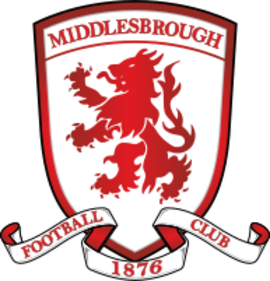 |
||||
| Full name | Middlesbrough Football Club | |||
|---|---|---|---|---|
| Nickname(s) | Boro, The Smoggies | |||
| Short name | MFC, Boro | |||
| Founded | 18 February 1876 | |||
| Ground | Riverside Stadium | |||
| Capacity | 34,742 | |||
| Owner | Steve Gibson | |||
| Chairman | Steve Gibson | |||
| Head coach | Michael Carrick | |||
| League | Championship | |||
| 2018–19 | Championship, 7th of 24 | |||
|
||||
Middlesbrough Football Club (![]() i/ˈmɪdəlzbrə/ mid-ƏLZ-brə) is a professional association football club based in Middlesbrough, North Yorkshire, England. The team competes in the EFL Championship, the second level of the English football league system.
i/ˈmɪdəlzbrə/ mid-ƏLZ-brə) is a professional association football club based in Middlesbrough, North Yorkshire, England. The team competes in the EFL Championship, the second level of the English football league system.
Nicknamed the Boro, they were formed in 1876 and are the 12th oldest football league club in England and Wales. The club have played at the Riverside Stadium since 1995, having previously played at Ayresome Park for 92 years, from 1903 to 1995.
Middlesbrough were one of the founding members of the Premier League in 1992, and have spent all but two seasons of their entire history competing within the top two tiers of English football. Their highest league finish to date was third place in the top flight in the 1913–14 season. The outbreak of the First World War stunted their push for a first top division title, though the club pushed again during the inter-war years, finishing fourth in the 1938–39 season before the Second World War halted the English leagues and again prevented a push for a first title. The club came within minutes of folding in 1986 before they were saved by a consortium led by then board member and later chairman Steve Gibson. A remarkable recovery saw the club immediately earn back to back promotions to the top division in the 1986-87 and 1987-88 seasons, the latter being the first and only time a second tier side directly relegated a first tier side through the English Football League play-offs. During the early Gibson years in the Premier League, the club signed several high-profile players in the hope of pushing to challenge at the very top of English football. Whilst this ultimately did not translate into the success that the club hoped for, suffering FA Cup and League Cup final defeats and a relegation in 1997 following a controversial 3 point deduction, and losing another League Cup final the following season, the club did go on to win the League Cup in 2004, its first major silverware, and reach the 2006 UEFA Cup final.
Middlesbrough is the only major professional football club in the greater Teesside area (the 14th biggest urban area in England), the Tees Valley, and the county of North Yorkshire (the largest county in England by land mass ). With no other major professional football clubs based in these areas, the club has no direct city 'derby', however it does contest wider regional rivalries with the three closest major clubs, Newcastle United (the Tyne–Tees derby), Sunderland (the Tees–Wear derby) and Leeds United (Yorkshire derby).
The club's traditional kit is red with white detailing, often in the form of a white chest band. The home shorts and sock colours have interchangeably been shifted between red and white, complementing the red shirt that was adopted in 1899. The various crests throughout the club's history, the most recent of which was adopted in 2007, incorporate a lion rampant.
Contents
- History
- Formation and early years (1876–1914)
- Ups and downs (1914–1966)
- Resurgence, 'Charlton's Champions', and financial crisis (1966–1994)
- Bryan Robson years (1994–2001)
- Return to top flight and venture into Europe (2001–2009)
- Decline, brief revival and relegation (2009–2017)
- Return to the Championship (2017–present)
- Colours and crest
- Stadiums
- Supporters
- Media relations
- Community
- Non-playing staff
- Players
- Notable players
- Honours
- Middlesbrough Women
- See also
History
Formation and early years (1876–1914)
Middlesbrough were formed in 1876, and won the FA Amateur Cup in 1895 and again in 1898. The club turned professional in 1889, but reverted to amateur status in 1892. They turned professional permanently in 1899. After three seasons, they won promotion to the First Division, where they would remain for the next 22 years.
In 1903, the club moved to Ayresome Park, their home for the next 92 years. In 1905, the club sanctioned the transfer of Alf Common for £1,000, a record fee. In the same year, Tim Williamson became the first Middlesbrough player to play international football.
Over these early years in the top flight, their form fluctuated greatly, rising to sixth in 1907–08 before dropping to 17th two seasons later. The club rose to their highest league finish to date, third, in 1913–14. The First World War soon intervened, and football was suspended.
Ups and downs (1914–1966)
Before league football resumed, Middlesbrough won the Northern Victory League, but the team were unable to maintain their previous form and finished the 1919–20 season in mid-table. They remained in the First Division for the next few seasons, but were relegated in 1923–24 after finishing bottom, 10 points adrift of their nearest rivals. Three seasons later, they won the Division Two title. During that season, debutant George Camsell, who had signed from Third Division North side Durham City the previous season, finished with a record 59 league goals, which included nine hat-tricks. He would continue as top scorer for each of the next 10 seasons. Middlesbrough's tenure back in the top flight lasted only one season, and the club were relegated. They were promoted at the first attempt in 1928–29, winning another Second Division title. The club remained in the First Division until 1954.
The decade before the Second World War saw the emergence of Wilf Mannion and George Hardwick, both of whom would go on to become England internationals in the years ahead. Middlesbrough climbed to fourth in the last full season before the war, and were expected to challenge for the title the following season, but the war intervened. After the war, the club was unable to recover the form of the previous seasons before the war, hovering around mid-table and exiting in the early rounds of the FA Cup. Soon after the war, the team began to falter, and were relegated in 1953–54. This was the start of a 20-year spell outside the top division, but this was the spell too that saw the emergence of one of the club's top goalscorers, Brian Clough, who scored 204 goals in 222 games, before he left for Sunderland. Over that period, Middlesbrough maintained reasonable progress in the Second Division, but were never serious contenders for promotion. After a fourth-place finish in 1962–63, the club endured a steady decline and were relegated to the Third Division for the first time in their history in 1966.
Resurgence, 'Charlton's Champions', and financial crisis (1966–1994)
New manager Stan Anderson returned the club to the second flight at the first attempt. Middlesbrough would not finish below ninth during the next six seasons in the Second Division, finishing 4th (just outside the top three promotion winning places at the time) on three of those occasions.
In 1973, Jack Charlton took over as manager and guided the team back to the top flight. A team led on the pitch by Willie Maddren and Bobby Murdoch, and including a young Graeme Souness, ensured promotion as early as 23 March 1974, and with eight games of the season left, they became runaway champions, finishing with a league record 65 points (based on the 2 points for a win format). After a very promising start to their first campaign back in the first division Bob Paisley, manager of eventual runners up Liverpool, tipped Middlesbrough as favourites to win the league, however they ultimately fell short finishing seventh. Middlesbrough won their first silverware as a professional side in the 1975–76 season, lifting the Anglo-Scottish Cup in its inaugural season after a two-legged final win over Fulham.
In 1979, John Neal made the clubs first international signing, with Boško Janković arriving from Željezničar Sarajevo.
The club experienced severe financial difficulties during the mid-1980s. Middlesbrough were dropping down the table, and finished 19th in the 1984–85 season. In April 1986, the club had to borrow £30,000 from the Professional Footballers' Association (PFA) to pay wages. The final game of the season saw Middlesbrough relegated to the Third Division again. That summer, the club called in the Provisional Liquidator, and, shortly afterwards, the club was wound up and the gates to Ayresome Park were padlocked. Without the £350,000 capital required for Football League registration, a new rule, it seemed inevitable that the club would fold permanently. Steve Gibson, however, a member of the board at the time, brought together a consortium, and with 10 minutes to spare before the deadline they completed their registration with the Football League for the 1986–87 season. Following the registration came both a change of club crest and a change of the official company name to Middlesbrough Football and Athletic Club (1986) Ltd.
Over the next two seasons, Middlesbrough gained successive promotions into Division Two and then into Division One. The next season, however, they came straight back down to Division Two, and with it came the then British transfer record move of Gary Pallister to Manchester United for £2.3 million. Following promotion again, Middlesbrough became one of the founding members of the FA Premier League when it was launched in the 1992–93 season.
Bryan Robson years (1994–2001)
Player-manager Bryan Robson, from Manchester United, took charge in 1994 and Middlesbrough were brought back into national attention. Following promotion to the Premier League and high-profile purchases like Brazilian international Juninho, many considered Middlesbrough to be on the rise. A difficult 1996–97 season, however, was compounded by a deduction of three points imposed just after Christmas as punishment for the club's failure to fulfil a fixture against Blackburn Rovers, which ultimately resulted in relegation. Without the points deduction imposed by the FA Premier League despite the club having taken advice from the Premier League themselves prior to calling off the match, the club would have had enough points to avoid the drop. At the same time, the club reached both the League and FA Cup finals for the first time, but lost both games. Despite being in the second tier, they were again runners-up in the League Cup final the next year.
Despite losing high-profile players Fabrizio Ravanelli and Juninho due to relegation, Middlesbrough were promoted back to the Premier League at the first attempt, in 1998. The following season saw them settle well and they had a 12-game unbeaten run midway through 1998–99, including a 3–2 win at Old Trafford in January during which they took a 3–0 lead; it was Manchester United's only home defeat during their treble-winning season. Middlesbrough continued to stay secure in mid-table the following season, thanks mainly to the goals of Hamilton Ricard and the signings of big name players such as Paul Ince and Christian Ziege. In 2000–01, they had a brief relegation scare that was solved with the arrival of Terry Venables as co-manager, and a 3–0 win away at Arsenal in April was the team's best result. The trend of buying European-based players continued with the acquisitions of Christian Karembeu and Alen Bokšić. Bryan Robson left the club before the start of 2001–02 season, having served as manager for seven years.
Return to top flight and venture into Europe (2001–2009)
Manchester United assistant coach Steve McClaren replaced Robson. The following seasons saw Premier League security maintained, as Middlesbrough slowly improved and were seen as a tough side to beat when playing at the Riverside Stadium. During McClaren's time as manager, Middlesbrough achieved their highest Premier League placing, finishing seventh in 2004–05.
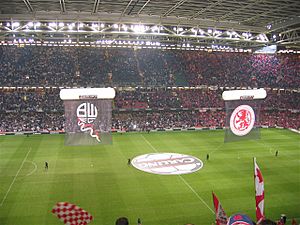
Under mcClaren, the 2003–04 season saw the club win a first major trophy by beating Bolton Wanderers 2–1 in the League Cup final under McClaren. The League Cup win also ensured that Middlesbrough would qualify for Europe – the UEFA Cup – for the first time, where they reached the last 16 of the competition. UEFA Cup qualification was achieved for the second consecutive year after an eventful 1–1 away draw with Manchester City, a game which concluded with a late penalty save from goalkeeper Mark Schwarzer, in the final game of the season.
The final Premier League game in the 2005–06 season, against Fulham, included the 15 of the 16 squad members from the local area (the exception was Malcolm Christie). When Josh Walker replaced Christie after 62 minutes, the 11 players on the field were all born within 30 miles of Middlesbrough and all graduates of the club's academy. This was the first all-English starting line-up in the Premier League since Bradford City in 1999, the first all-English match squad since Aston Villa in 1998 and the youngest starting line-up in Premier League history.
Middlesbrough reached the 2006 UEFA Cup final in Eindhoven, following two comebacks from 3–0 down in the rounds preceding it, but lost 4–0 to Sevilla.
Following the cup final loss, McClaren left to manage the England national team, and captain Gareth Southgate took over. Despite not having the coaching qualifications, he was allowed by the Premier League board to continue after receiving special dispensation. During the 2007–08 season, Southgate broke Middlesbrough's record transfer fee, paying £13.6 million for Brazilian international striker Afonso Alves. Southgate's first two seasons saw the club finish in 12th and 13th places. He oversaw the club reaching the quarter-finals of the FA Cup for three seasons, but the club was relegated to the Championship at the end of the 2008–09 season.
Decline, brief revival and relegation (2009–2017)
Middlesbrough sacked Gareth Southgate as manager in October 2009, when Southgate's team were one point from leading the Championship, and replaced him with Gordon Strachan. At the time of Southgate's dismissal, Boro were fourth in the Championship but their form under Strachan declined and they finished mid-table. On 18 October 2010, Strachan resigned and was later replaced by Tony Mowbray. Following a poor run of form at the start of the 2013–14 campaign, Mowbray left the club with immediate effect on 21 October.
Aitor Karanka, a former assistant coach at Real Madrid to José Mourinho, became the new Middlesbrough manager. He became the first non-British manager at the club, and led Boro to a 12th place finish. In Karanka's first full season in charge, Middlesbrough finished fourth and thus qualified for the 2015 Football League play-offs. After defeating Brentford 5–1 on aggregate in the semi-final, the club lost 2–0 to Norwich City at Wembley Stadium in the final. The next season, Middlesbrough were promoted back to the Premier League after finishing second in the Championship in 2015–16, drawing 1–1 with Brighton & Hove Albion on the final day of the season.
Middlesbrough sacked Karanka in March 2017 following a poor run of form, and the team were relegated in 19th place, after just one season back in the top flight. The team won only 5 league games, and scored 27 goals, the lowest in the league.
Return to the Championship (2017–present)
The club appointed former Leeds United manager Garry Monk as manager in the off-season. Expectations at the club were high, having spent close to £50 million in the transfer window on player purchases, in order to mount an immediate promotion challenge back to the Premier League. Monk left in December, with Middlesbrough ninth in the Championship, and Tony Pulis was appointed as his replacement. Pulis led the side to finish 5th in the table, however, they lost in the play-off semi-finals to Aston Villa. In the following season, Pulis looked to secure the play-offs once again, but a poor finish to the season caused them to finish 7th and miss out on the play-offs by one point.
When Pulis's contract was not extended, he was replaced by former Middlesbrough defender and first team coach, Jonathan Woodgate on 14 June 2019 on a three-year contract. From March to June 2020, the 2019–20 season was suspended due to the COVID-19 pandemic. On 23 June 2020, Woodgate was sacked with the club only outside of the relegation zone on goal difference. Neil Warnock was appointed as his replacement on the same day. Warnock ensured survival from relegation, securing safety on the final day of the season and a 17th-place finish. On 6 November 2021, Middlesbrough parted company with Warnock, who was replaced by Chris Wilder the following day. After 11 months in charge, Wilder was sacked with the club in 22nd position.
Former Manchester United midfielder Michael Carrick was appointed as his successor and led Boro to a fourth place finish, but lost in the play-off semi-finals against Coventry City. On 26 May 2023, the club officially became affiliated with the women's team. In the 2023–24 season, Middlesbrough reached the semi-finals of the League Cup for the first time since 2004. Despite defeating Chelsea in the first leg, Middlesbrough would lose 6–2 on aggregate.
Colours and crest
|
|
| Early Middlesbrough F.C. kit |
Middlesbrough's original home kit upon election to the Football League in 1899 was a white home shirt with red shorts, and they did not adopt their colours of blue and white until later that season. Previous kits included a white shirt with a red and white polka dotted collar from around 1889. The Middlesbrough kit has remained broadly the same since 1899; a red shirt with white detailing, with shorts and socks of either red or white. The distinctive broad white stripe across the chest was introduced by Jack Charlton in 1973 (following an attempt to change the home shirt to a Leeds United-style white shirt), and brought back for a one-off in 1997–98, and, then again, for the 2000–01 and 2004–05 seasons due to popular demand. The club subsequently announced in December 2007 that the club would allow fans to decide via an online and text vote whether the white band should return for the following season. On 8 January 2008, the club announced that, with 77.4% of voters voting in its favour, the white band would return to the home kit, and that fans would choose the final shirt appearance from a selection of three designs, of which the winner was announced on 7 May 2008.
The Middlesbrough crest has gone through four changes since the formation of the club. Initially, the badge was simply the town of Middlesbrough's crest with a red lion instead of a blue lion in order to fit in with the club's colours. Following the adoption of the white band on the shirts in 1973, only the red lion remained with the letters "M.F.C" underneath in red. This was further adapted following the reformation of the club in 1986 to a circular crest with the lion in the middle and the words "Middlesbrough Football Club 1986" around the circle in order to reflect this new era. In 2007, Middlesbrough changed their crest again, this time with the lion inside a shield and the words "Middlesbrough Football Club 1876" underneath. The club's chairman Steve Gibson stated that the intention was to reflect the club's long history and not just their post-liquidation status.
Kit information
Middlesbrough's first sponsor in 1980 was Datsun Cleveland on a two-year deal. Further two-year deals continued until Dickens was the sponsor for the 1994–95 season only. From 1995 to 2002, the club was sponsored by mobile phone service Cellnet, followed by two years with mobile retailer Dial-a-Phone. Online casino 888.com (2004–07) and satellite navigation company Garmin (2007–10) followed. In 2010–11, the club had several temporary sponsors including pawnbrokers Ramsdens, who then became permanent sponsors and signed a five-year deal in 2013. At its end, 32Red became the sponsors. Early in Ramsdens' sponsorship in March 2011, the company ceded its advertising space to Marie Curie Cancer Care for two games.
Italian manufacturers Erreà made Middlesbrough's kits from 1994 to 2009, when the role was taken up by Adidas, who had previously made the kits from 1979 to 1983. Danish company Hummel, which had made the kits from 1984 to 1987 during the club's winding up and rebirth, secured the contract again in 2018. Erreà returned in 2022.
| Period | Kit manufacturer | Shirt sponsor |
|---|---|---|
| 1976–1977 | Bukta | None |
| 1977–1980 | Adidas | |
| 1980–1982 | Datsun Cleveland | |
| 1982–1984 | McLean Homes | |
| 1984–1986 | Hummel | Camerons |
| 1986–1987 | Dickens | |
| 1987–1988 | Skill | |
| 1988–1990 | Heritage Hampers | |
| 1990–1992 | Evening Gazette | |
| 1992–1994 | Admiral | ICI |
| 1994–1995 | Erreà | Dickens |
| 1995–2002 | BT Cellnet | |
| 2002–2004 | Dial-a-Phone | |
| 2004–2007 | 888.com | |
| 2007–2009 | Garmin | |
| 2009–2010 | Adidas | |
| 2010–2017 | Ramsdens | |
| 2017–2018 | Ramsdens Currency | |
| 2018–2022 | Hummel | 32Red |
| 2022– | Erreà | Unibet |
Stadiums
After formation in 1876, and with the club still amateurs, Middlesbrough's first two years of football were played at Albert Park in Middlesbrough. After seeing the damage being caused by players and supporters, the Park Committee ordered the club to find an alternate venue. The club moved to Breckon Hill, behind the former Middlesbrough College longlands site, after agreeing to rent the land from its owner. However, two years later in 1880, the owner increased the rent and the club decided to move. They moved into the Linthorpe Road ground in 1882, home at the time of Middlesbrough Cricket Club. The cricket club departed in 1893–94 to move to the Breckon Hill field, and Middlesbrough Football Club became sole users of the ground.
With the club's growing size, and entry to the Football League, they had to move to a new ground in 1903, Ayresome Park. It was designed by Archibald Leitch and would be the club's home for the next 92 years, having also been chosen as one of the stadia for the 1966 FIFA World Cup. Following the Taylor Report in 1990, the ground either needed modernising or the club needed a new stadium. The club decided on the latter, and moved out at the end of the 1994–95 season. Ayresome Park was used as a training ground during 1995–96, before it was demolished in 1997 and a housing estate built in its place. Since the 1990s, the club trains at a £7 million complex at Rockliffe Park, in Hurworth, on the outskirts of Darlington.
The Riverside Stadium, named by the supporters of the club after a vote, became the club's home in 1995. It was the first stadium to be built in line with the Taylor Report's recommendations on all-seater stadiums for clubs in the top two divisions of the English football league system. It was originally a 30,000-seater stadium, constructed at a cost of £16 million, before it was expanded in 1998 to a capacity of 35,100 for an extra £5 million.
Since then, several reorganisations of the Riverside Stadium have taken place. At the start of the 2013–14 season, away fans were moved from behind the goal in the South stand to the South East corner, while home fans were situated behind both goals to help create a better atmosphere inside the stadium. A giant TV screen was also installed at the back of the South-East corner, replacing the older style scoreboards attached to the North and South stand roofs. For the start of the 2016–17 season (and a return to the Premier League), the club had to improve the stadium's broadcasting facilities and floodlighting in order to meet Premier League requirements. The club also took this opportunity to move the main camera gantry to the back of the East stand, so that it faced the main West stand. As of the 2017–18 season, the stadium capacity is 34,742.
Supporters
Traditionally, supporters come from Middlesbrough itself and towns in the immediate area. As of May 2001, Middlesbrough had one of the highest proportions in Britain of locally-born season ticket holders at 80%, and one of the highest proportions of female fans at 20%. A survey at the start of the 2007–08 season found Middlesbrough supporters were the seventh-loudest set of fans in the Premier League. Middlesbrough Official Supporters Club, which features its own team in the local football league, has links with supporters' clubs across the globe. The largest supporters' clubs include the Official Supporters' Club, the Middlesbrough Disabled Supporters' Association, Yarm Reds, Red Faction and Middlesbrough Supporters South.
For Middlesbrough supporters, their main rivals are Newcastle United (with whom they contest the Tyne–Tees derby), followed by Sunderland (with whom they contest the Tees–Wear derby), and also, according to a planetfootball.com's 2004 survey, Leeds United.
The nickname Smoggies was first used as a derogatory term by opposing supporters; it relates to the industrial air pollution – smog – that used to hang over the town, but it was later used by Middlesbrough fans in a somewhat self-deprecating manner, before finally being adopted as a badge of pride by supporters of the club. An example of this can be seen on the banners carried to away games stating "Smoggies on Tour". Middlesbrough fans received praise from UEFA Chief Executive Lars-Christer Olsson after their behaviour during the 2005–06 UEFA Cup campaign. He commented that:
You have the satisfaction of knowing that, although your team did not win the game, your supporters present in Eindhoven proved to the world that football fans can turn a match into a friendly, violence-free celebration.
Middlesbrough fans also received praise from Cleveland Police for their behaviour in previous rounds, particularly in the light of aggravation prior to and during the match at Roma.
Media relations
Middlesbrough was the first football club in the world to launch its own TV channel – Boro TV. The first broadcasts were tied to the club's first ever major cup final appearance in 1997, a full year ahead of Manchester United's MUTV, which still claims to be the first in the world. The channel was the brainchild of then NTL marketing director, Peter Wilcock. The programme became synonymous with former Middlesbrough player Bernie Slaven and radio commentator Alastair Brownlee, who proved to be as popular on TV as they were on radio. Its programmes were not live initially but were pre-recorded and hosted by local radio/TV broadcaster & Boro fan, Dave Roberts. In August 2001, Boro TV claimed another first when it became the first English football club to broadcast time-delayed full-match footage of their league games on its own channel. Boro TV ran through NTL cable television until July 2005. The club then began to show match highlights through a subscription-based scheme on its official website.
Middlesbrough's official matchday programme, Redsquare, was Programme Monthly's 2006–07 Programme of the Year. There are numerous other fanzines available, most notably Fly Me to the Moon, formed in September 1988 following Bruce Rioch's quote to Tony Mowbray, stating "If I had to go to the moon I'd want him by my side".
Community
Middlesbrough Football Club in the Community (MFCIC) was founded in 1996 by club chairman Steve Gibson and is one of the largest community-based football schemes in the United Kingdom. It is run separately from the football club, but receives support from both the club in terms of providing players, staff, stadium facilities and PR for articles in the matchday programme and other publications, as well as support from other local organisations. In 2012, MFCIC was relaunched as MFC Foundation. The Foundation aims to use the club's profile to deliver sport, health, education and inclusion projects in vulnerable and disadvantaged communities across Teesside. Since 1996, the Foundation has delivered 20,000 qualifications, engaged over 500,000 people and invested £25 million in local communities to tackle inequality and disadvantage.
Since 2002, the club and MFCIC have also run the Middlesbrough Enterprise Academy, a scheme which helps local children improve their entrepreneurial skills and increase their awareness of business planning and finance. In March 2008, plans were announced by the Premier League to roll out the scheme nationally amongst all Premier League clubs.
It was announced in December 2007 that Middlesbrough football club had carried out more community work during 2006–07 than any other Premier League club, rising from second place the previous year, with the club making 318 appearances – almost twice the Premier League average of 162. They were in the top two for community appearances again in 2007–08, with 374 – a 17% increase on the previous season.
Middlesbrough's mascot is Roary the Lion. The club runs Roary's Children's Charity Fund, which purchases items for local children's charities.
In 2009, steel producer Corus Group announced the possibility that it would mothball its Teesside plant, with up to 4,000 employees and contractors facing redundancy, after a consortium of steel magnates walked away from a 10-year deal. Middlesbrough Football Club helped with the "Save Our Steel" campaign by hosting dozens of steel workers and their families as they marched around the ground, promoted the campaign via the stadium's PA system, scoreboards and in matchday programmes, while players wore T-shirts during warm-ups promoting the campaign. Chairman Steve Gibson said:
"Middlesbrough Football Club exists for the community, for the people of Teesside—and the closure of the steel plants threatens to rip the heart out of our community. We cannot stand by and allow that to happen. We want the steelworkers and their families to know that we are behind them and will help their campaign in any way we can ... We like to think that the football club is the flagship of Teesside. Well this is our town and these are our people and we have to do what we can to help them."
European Football
| Middlesbrough in Europe | ||||||||
|---|---|---|---|---|---|---|---|---|
| Season | Competition | Round | Country | Club | Home | Away | Aggregate | |
| 2004–05 | UEFA Cup | First round | Baník Ostrava | 3–0 | 1–1 | 4–1 | ||
| Group E | Egaleo | N/A | 0–1 | 1st | ||||
| Lazio | 2–0 | N/A | ||||||
| Villarreal | N/A | 0–2 | ||||||
| Partizan Belgrade | 3–0 | N/A | ||||||
| Round of 32 | Graz | 2–1 | 2–2 | 4–3 | ||||
| Round of 16 | Sporting Lisbon | 2–3 | 0–1 | 2–4 | ||||
| 2005–06 | UEFA Cup | First round | Skoda Xanthi | 2–0 | 0–0 | 2–0 | ||
| Group D | Grasshoppers Zürich | N/A | 0–1 | 1st | ||||
| Dnipro Dnipropetrovsk | 3–0 | N/A | ||||||
| AZ Alkmaar | N/A | 0–0 | ||||||
| Litex Lovech | 2–0 | N/A | ||||||
| Round of 32 | Stuttgart | 0–1 | 2–1 | 2–2a | ||||
| Round of 16 | Roma | 1–0 | 1–2 | 2–2a | ||||
| Quarter-final | Basel | 4–1 | 0–2 | 4–3 | ||||
| Semi-final | Steaua Bucharest | 4–2 | 0–1 | 4–3 | ||||
| Final | Sevilla | 0–4 | ||||||
Non-playing staff
Corporate hierarchy
| Position | Name |
|---|---|
| Chairman | Steve Gibson |
| Chief Executive | Neil Bausor |
| Head of Football | Kieran Scott |
| Club Secretary | Karen Nelson |
Coaching staff
| Position | Name |
|---|---|
| Head Coach | Michael Carrick |
| Assistant Head Coach | Jonathan Woodgate |
| First-Team Coach | Aaron Danks |
| Goalkeeping Coach | Alan Fettis |
| Fitness Coach | Nick Allamby |
| Performance Analyst | Phill Hudson |
| Head Physio | Chris Moseley |
| Chief Medical Officer | Rob Tatham |
| Physician | Dr. Bryan English |
| Sports Scientist | Frankie Hunter |
| Kit Man | Peter Darke |
Academy coaching staff
| Position | Name |
|---|---|
| Academy Manager | Craig Liddle |
| Head of Player Pathway and Development | Leo Percovich |
| Professional Development Phase Coach (U21s) | Mark Tinkler |
| Professional Development Phase Coach (U18s) | James Marwood |
| Academy Goalkeeping Coach | Chris Pennock |
| Head of Academy Recruitment | Martin Carter |
| Head of Education and Welfare | Barry Dawson |
Managerial history
The following are all the full-time Middlesbrough managers since the club turned professional in 1899.
|
|
Players
Current squad
|
|
Out on loan
|
|
Reserves and Academy
Notable players
Middlesbrough Legends
These 10 players were voted for by fans as part of a campaign with the Evening Gazette.
 George Camsell
George Camsell George Hardwick
George Hardwick Wilf Mannion
Wilf Mannion Brian Clough
Brian Clough John Hickton
John Hickton Willie Maddren
Willie Maddren Tony Mowbray
Tony Mowbray Bernie Slaven
Bernie Slaven Juninho
Juninho Gareth Southgate
Gareth Southgate
Top appearances
These players made more than 430 appearances during their time at the club. The number in brackets indicates the number of appearances in all competitions.
- Tim Williamson (602)
- Gordon Jones (532)
- John Hickton (499)
- John Craggs (487)
- Jim Platt (481)
- George Camsell (453)
- Jacky Carr (449)
- Mark Schwarzer (446)
- David Armstrong (431)
Top goalscorers
These players scored more than 140 goals during their time with the club. The number in brackets indicates the number of goals scored in all competitions.
- George Camsell (345)
- George Elliott (213)
- Brian Clough (204)
- John Hickton (193)
- Micky Fenton (162)
- Bernie Slaven (146)
- Alan Peacock (141)
Player of the Year award winners
|
|
|
|
|
Football League 100 Legends
The Football League 100 Legends is a list of 100 legendary football players produced by The Football League in 1998, to celebrate the 100th season of League football.
- Alf Common
- George Camsell
- Steve Bloomer
- Wilf Mannion
- George Hardwick
- Nobby Stiles
- Graeme Souness
- Bryan Robson
- Paul Gascoigne
English Football Hall of Fame
The English Football Hall of Fame is housed at The National Football Museum in Manchester, England. The Hall aims to celebrate and highlight the achievements of top English footballers and footballers who have played in England. These players appeared for or managed Middlesbrough at some point in their careers.
- Brian Clough (2002 inductee)
- Paul Gascoigne (2002 inductee)
- Bryan Robson (2002 inductee)
- Viv Anderson (2004 inductee)
- Wilf Mannion (2004 inductee)
- Jack Charlton (2005 inductee)
- Graeme Souness (2007 inductee)
- Nobby Stiles (2007 inductee)
- Terry Venables (2007 inductee)
- Steve Bloomer (2008 inductee)
- Malcolm Allison (2009 inductee)
- Raich Carter (2013 inductee)
- Paul Ince (2021 inductee)
Scottish Football Hall of Fame
The following former Middlesbrough players and managers have been inducted into the Scottish Football Hall of Fame.
- Bobby Murdoch (2004 inductee)
- Graeme Souness (2004 inductee)
- Gordon Strachan (2007 inductee)
Honours
Source:
League
- Second Division / First Division / Championship (level 2)
- Champions: 1926–27, 1928–29, 1973–74, 1994–95
- Runners-up: 1997–98, 2015–16
- Play-off winners: 1988
- Third Division (level 3)
- Runners-up: 1966–67, 1986–87
- Northern League
- Champions: 1893–94, 1894–95, 1896–97
Cup
- FA Cup
- Runners-up: 1996–97
- League Cup
- Winners: 2003–04
- Runners-up: 1996–97, 1997–98
- Full Members' Cup
- Runners-up: 1989–90
- FA Amateur Cup
- Winners: 1894–95, 1897–98
- UEFA Cup
- Runners-up: 2005–06
- Anglo-Scottish Cup
- Winners: 1975–76
- North Riding Senior Cup
- Winners on 55 occasions since 1882
- Kirin Cup
- Winners: 1980
Middlesbrough Women
Middlesbrough Women is the women's football club affiliated to Middlesbrough. Founded as Cleveland Spartans in 1976, they became officially affiliated with the men's team in 2023, and currently play in the FA Women's National League Division One North, the fourth level of English women's football.
See also
 In Spanish: Middlesbrough Football Club para niños
In Spanish: Middlesbrough Football Club para niños


